|
Monday, August 9, 2010
Progress Notes
Located as we are here in Miller County, an area where many natural streams are located including the third largest river in the state (Osage River) as well as one of the largest lakes in the nation (Lake of the Ozarks), it is understandable why fishing always has been a very popular activity. The most common fishing stories are about the “big ones that got away.” However, sometimes the big ones are caught and the stories of the battle between man and fish always is entertaining. For example, in a previous Progress Notes of March 23, 2009 I presented the story of Barney Tyler catching the largest Sturgeon ever caught in Missouri while fishing on the Osage River (photo 01).
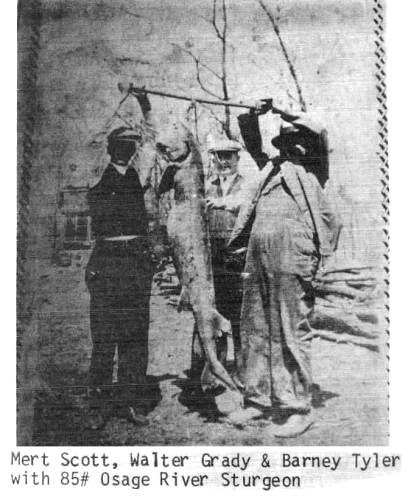
01 Big Sturgeon caught on Osage Another Miller County native who knew how to catch the big ones was Clark Vanosdol (photo 02). He often fished the Osage River even before the dam was built and was a fisherman for whom catching huge fish was easy.
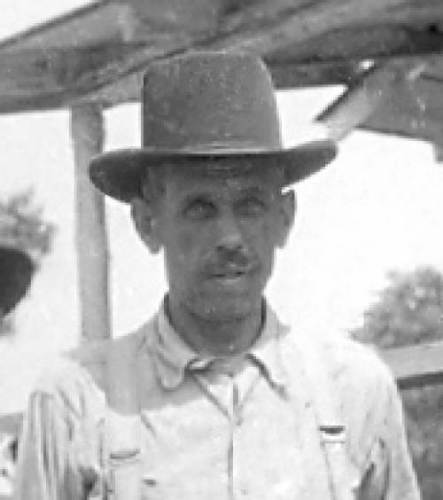
02 Clark Vanosdol Here are three photos of fish Clark caught after a day on the Osage (photos 03, 04 and 05):
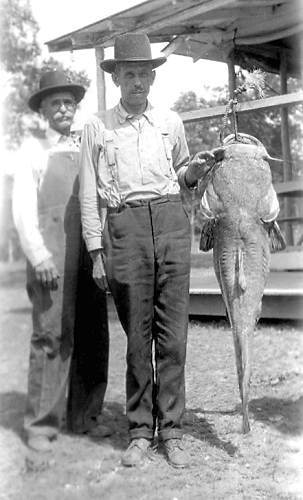
03 Clark holding one of his Big Catfish
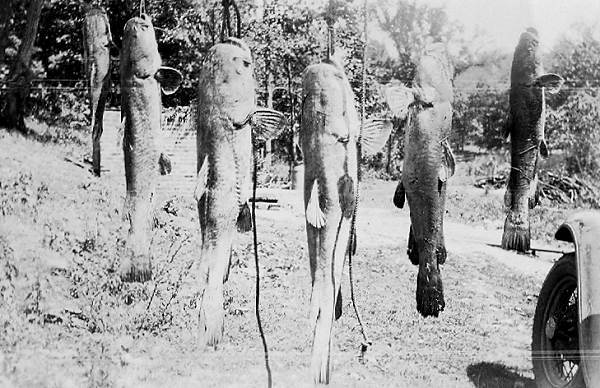
04 More catfish caught by Clark
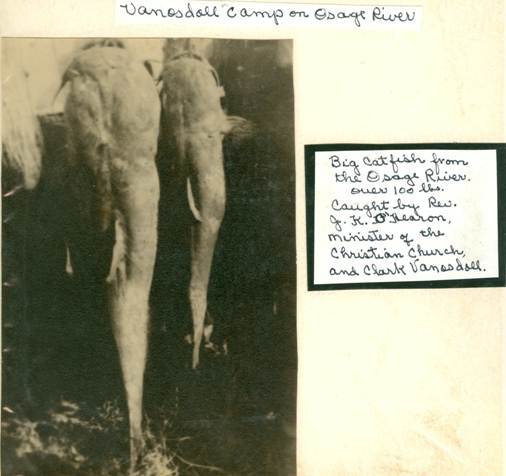
05 And even more big fish caught on the Osage River by Clark You can read more about Clark Vanosdol at this previous Progress Notes.
The story of the landing of another huge fish, a sixteen pound Jack Salmon, was told by Alan Wright about his father Garsy in a previous Progress Notes of July 6, 2009. Here is a painting by John Wright, Garsy’s father, showing Garsy in the lower right hand corner landing the big fish (photo 06).
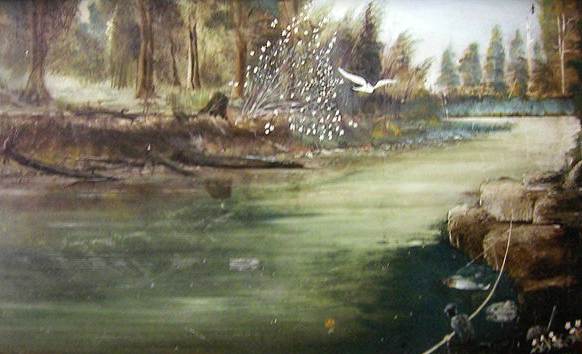
06 Jack Salmon on the Glaize But perhaps the most famous Miller/Camden County fisherman to catch big fish was John McGowin (or McGowan). Here is a photo of John with one of the really big fish he caught regularly on the Osage River (photo 07):
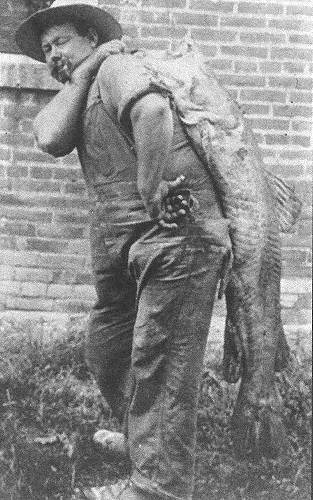
07 John McGowan with big Catfish John originally was from Vernon County, Missouri but most of his life was spent in the Linn Creek area. After the dam was built he moved to Bagnell where his children followed and raised their children. Dwight Weaver, local historian of the lake area, provided a short narrative about John which was published recently in Lake of the Ozarks Business Journal (July 2010):
Fisherman John
From the collection of Dwight Weaver
Published in Lake of the Ozarks Business Journal
July 2010
The Lake of the Ozarks hosts hundreds of amateur and pro bass fishing tournaments each year and is a stop on several regional and national tournament circuits. Some of the region’s fishing champions are well known local fishing guides. What is less well known is that the Osage River basin was a destination for amateur and champion fishermen long before the ideas for Bagnell Dam and Lake of the Ozarks were born.
One focal point for early fishing activity was near the junction of the Big Niangua and the Osage rivers. Even in the 1880’s and 1890’s there were summer cottages for fishermen in the hills along both rivers. They often relied upon the skills of local fishing guides like John McGowan, known affectionately as “Fisherman John.” John’s home was just a few feet from the water’s edge near the mouth of Linn Creek valley. He also had several cottages, which he rented to fishermen who retained his services. In his day he was considered the “champion Waltonite” of the Osage River basin. By the time the construction of Bagnell Dam began he was elderly but still catching”the big ones.” The photo that accompanies this article, courtesy of the Camen County Historical Society, was taken in 1909 and shows John with one of his catches (see photo 07 above).
When told about the coming Dam and Lake, fisherman John was skeptical. “I hain’t got no idear they’ll go through with it,” he said. “But if they do, I’ll get more money for my land ‘cause of them cottages.”
When his land and cottages were later beneath 50 feet of water, John moved to old Bagnell where he died of a heart attack at age 85 on May 21, 1938. He left a wife, four daughters, two sons, 32 grandchildren and two great grandchildren. He’s buried in the Riley Lamm cemetery.
More information about the big fish John was carrying over his shoulder in the photo above is told by Nelta Pope Morgan in her history of the Pope family which lived many years in the Bagnell area.
“Many huge fish were pulled from the Osage River. One was so big that the fisherman could not drag it into his boat. He towed it behind his boat to Bagnell where he got help landing the fish. Estimated at a weight of one hundred thirty five pounds, the fish was taken by wagon to the depot where it was loaded onto the train. Wet tow sacks were wrapped around the fish and cool water poured over it to keep it alive. It was transported to Jefferson City where it was sold.”
This quote by Nelta was taken from a previous Progress Notes of January 12, 2009.
Nelta used the same photo as shown above but with her own caption which gives more information about the fish (photo 08).
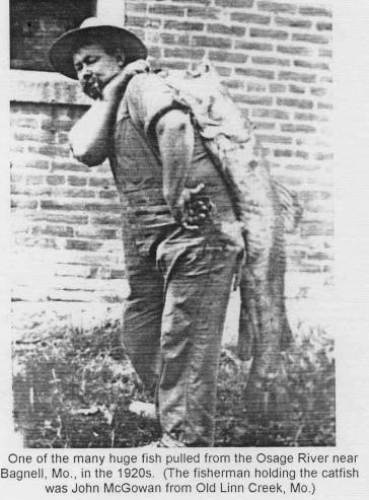
08 John McGowan with fish - Photo from Nelta Pope A third copy of this same photo is owned by Buster McGowin of Ulman, grandson of John McGowin, which gives more detail in its caption (photo 09).
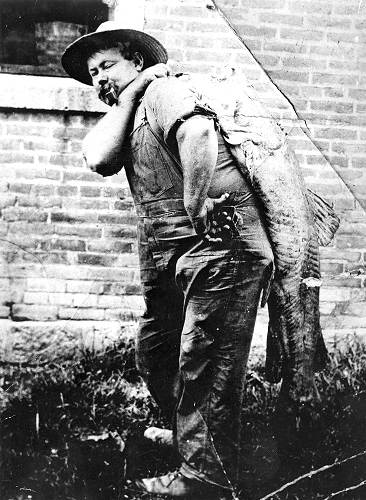
09 Fishin John McGowin - 1914
In front of Linn Creek Courthouse with ninety pound Flat Head I’m not sure if the big fish in these three photos was landed at Linn Creek or Bagnell from the above captions since some difference of opinion is present; but I think it probably occurred in Linn Creek based on Buster’s more specific caption.
John McGowin’s granddaughter, Kathrin McGowin Ryan, often attends the Old Bagnell reunion held each year. I was there a couple of years ago and took these photos of the event which included her as well as her sister Nellie (photos 10 and 11).
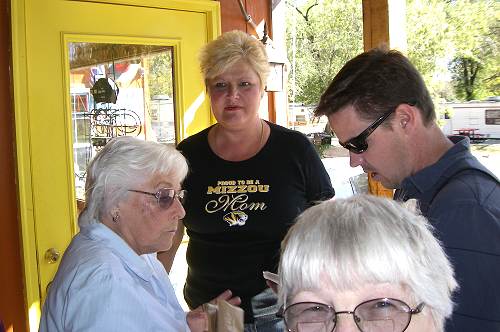
10 Kathrin McGowin Ryan, Pat Schulte and Brian Fleagle
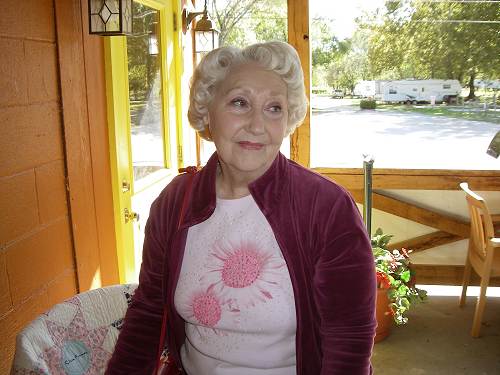
11 Nellie McGowin At that meeting, Kathrin supplied me with a McGowin family history which I will copy here:
McGowin Family History
Kathrin McGowin Ryan
William Johnson McGowin (John) was born in 1871 in Vernon County, Missouri. His ancestry, traced through his mother Ellen Hurst, goes back to England in 1600. The McGowin name had several spelling versions. Some spelled McGowan and some spelled McGowen.
In 1894, in Burlington, Kansas, John married Etta Dora Graybeal (Dorrie) (photo 12).
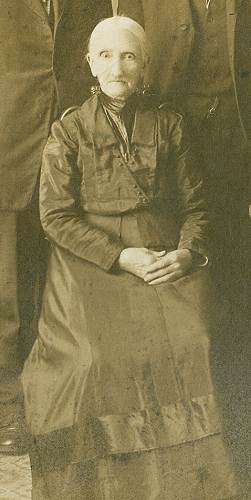
12 Etta Graybeal Since that time, our name has been spelled McGowin.
Dorrie’s ancestry, through her mother Elizabeth Terrell, traces back to 1600 England, and through her father William Graybeal to 1500 Emme Valley near Berne, Switzerland. Graybeal was (Kraenbuehl) meaning Crow Hill. The family Coat of Arms was a Crow.
John and Dorrie left Kansas on a houseboat. When they reached Linn Creek, they stayed and built a home on the Osage River. They had six children, all of whom grew up there.
With the construction of Bagnell Dam across the Osage River, the Lake of the Ozarks was formed and covered, among others, the McGowin home.
John and Dorrie bought 40 acres of land near Bagnell (Penny Town) and built a home and four cabins of oak and cedar, all with screened in front porches.
John and Dorrie told stories of being in Oklahoma territory during the Yellow Fever epidemic. Her brother Joseph died and John was very sick with the fever. Dorrie strapped a pistol around her waist and drove their wagon out of Oklahoma into Kansas just before the Territory was quarantined. The hardships they endured, showed the courage of their ancestors, who a century before came to America seeking religious freedom. John and Dorrie enjoyed their years at Bagnell.
In 1929, Archabald Commodore Griggs was working as a painter for the Town of Bagnell. His daughter, Frata Jo, met and married John and Dorrie McGowin’s son, Josh.
John died in 1938 and Josh bought the farm. Josh and Frata had six children; Jim, Kathrin, Nellie, Buck, Josh Jr. (Buster), and Danny (photo 13 of family).
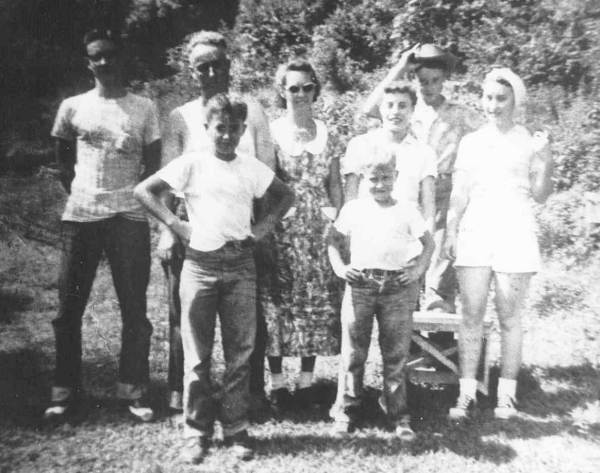
13 McGowin Family Left to Right : Jim, Josh, Buster, Frata, Danny, Kathrin, Buck and Nellie During the depression, our dad worked on the Bagnell Dam Project. He also fished and traded fresh fish for other commodities.
During the early years of World War II, we left the farm, and our dad, a lineman, worked building Defense Plants in Kansas, Oklahoma, and Arkansas. We returned to the farm in 1944. Growing up in the 40’s in Bagnell was a fun time. We had the usual work to be self supporting. We raised much of our food in a garden, had a cow, a horse, a Jenny, and chickens. We churned our own butter, and canned much of the vegetables from the garden. We had our own well for water and of course, we had to draw water for the animals. You have no idea how many gallons of water those animals could drink on a hot summer day.
In the summer, there were community fish fries and picnics. In the winter, when ice froze on the river bluffs, the boys would take a sled and bring ice home. We would have home made ice cream, peach cobbler and play games. We didn’t get prizes, we only had the satisfaction of winning, or the disappointment when we lost. It was still fun.
Our Grandmother Dorrie died at home on the farm in 1948. In researching family stories about her when she was growing up in the 1870’s, 80’s and 90’s in Coffee County, Kansas, we discovered we had our own family heroine.
We lost our brothers Buck and Danny recently. Danny could light up a room and tell stories and keep you laughing. Buck was a history buff and could keep you entertained for hours. Both Danny and Buck liked to fish and hunt and had many stories about the ones that got away. They were both electricians and proud of their roots in Bagnell.
I toured many Cathedrals in Europe in the 60’s and 70’s and my thoughts would always turn to a White Oak Church in the Valley of Bagnell. I can still remember how beautiful the sound of the bell was on a Sunday Morning.
Josh McGowin, Kathrin’s father, was himself quite a fisherman who could catch the big ones as this photo given me by his son Buster McGowin reveals (photo 14).
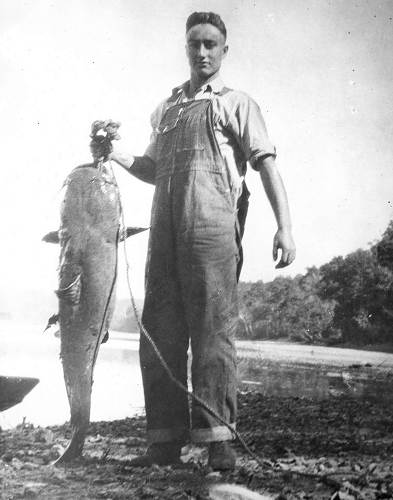
14 Josh McGowin - Age 22 at Old Bagnell This particular fish was a 65 pound blue cat caught in the Osage River on a trot line. Here is a photo of the jenny Kathrin mentioned in her narrative above pulling some of the children in a wagon (photo 15):
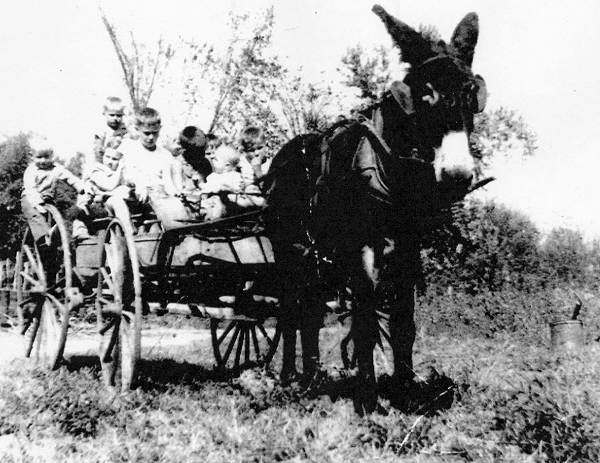
15 Left to Right: Danny McGowin, two cousins, Buck, Buster, two more cousins and Kate the Donkey And here is another photo of Josh and Frata McGowin’s family in front of their home in Penny Town (photo 16):
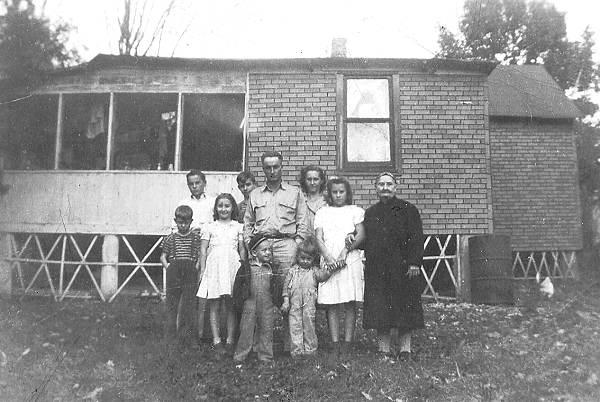
16 Josh McGowin Family in front of home in Pennytown Two of Kathrin’s brothers, Jim and Buster McGowin, both grandchildren of John McGowin, the Osage River fisherman, are well known in Miller County. Jim ran a brake repair shop in Osage Beach for a number of years and after selling that business became a minister. He died two years ago after having been the preacher at the Ulman Christian Church for more than ten years (photo 16a):
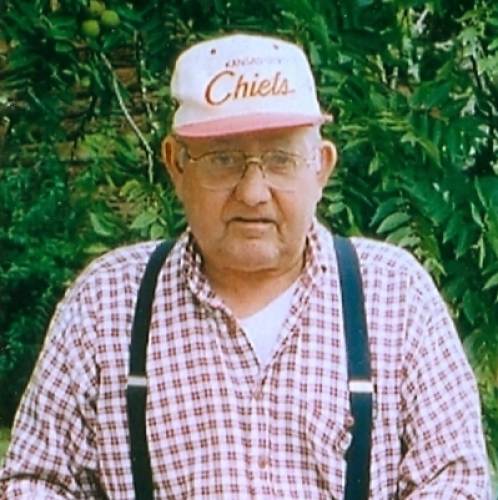
16a Jim McGowin Jim’s brother, Buster McGowin, has been an elder at the Christian church in Ulman for many years. Buster is very well known having been an educator both at the Eldon School system and later at the School of the Osage where he was Principal for many years.
Buster is married to Myna Patterson, daughter of Tennyson and Nita Patterson, who for many years owned a general store in Ulman. After Buster and Myna married they established their home in Ulman. Here is a recent photo of Buster and Myna (photo 17).
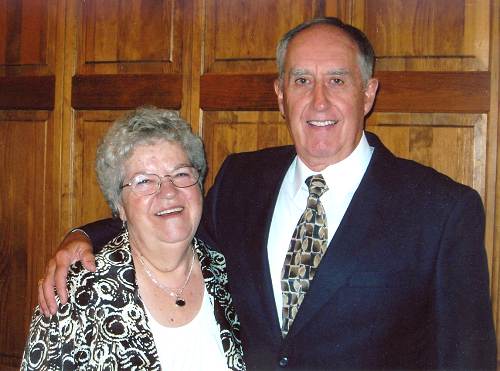
17 Myna and Buster McGowin About a month ago Buster and Myna very generously donated to us the old charter of the Ulman Modern Woodmen of America Fraternal Lodge (photos 18 and 19).
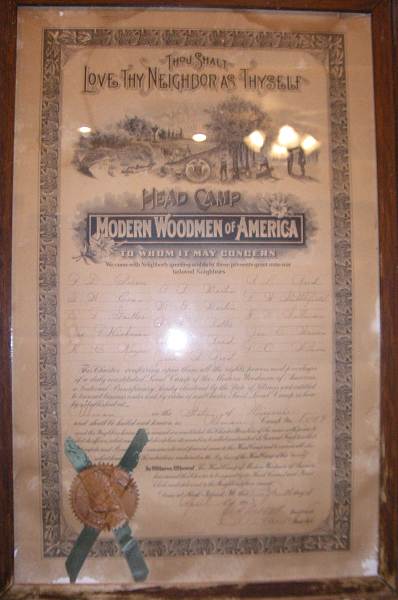
18 Woodman of America Charter
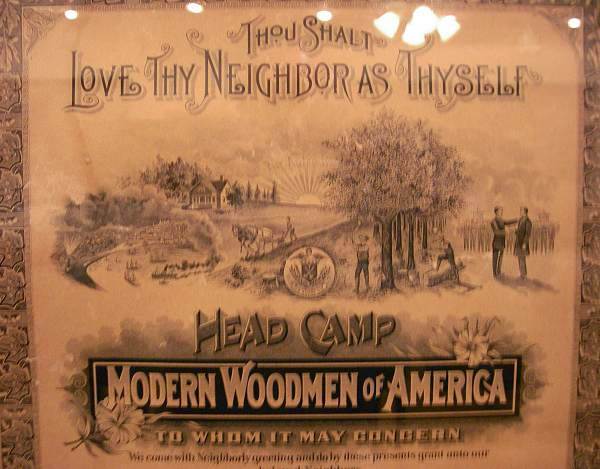
19 Woodman of America Charter This group met in a building next to the Christian Church in Ulman. The original meeting building no longer is present and in its place is the garage of the current owner of the property, Mike Patterson. The Modern Woodmen of America was a fraternal lodge founded in 1883. It was created to protect families following the death of a breadwinner. You can read much more about this organization at a previous Progress Notes where I discussed the Woodmen of America Fraternal Lodge of Tuscumbia.
I have known Buster for a long time beginning when he was playing basketball at School of the Osage. Because Logan Stone, who lived at Ulman, was a teacher at Tuscumbia, Buster often would come with Logan to the Tuscumbia gym to practice and play basketball. That is where I first met him. Later he played “Town Team Basketball” as a member of the Tuscumbia team. He was one of the best basketball players I ever knew. Since then in more recent years we hunted birds together in Texas.
Buster and Myna’s son, Sheldon, has been very interested in the history of his home town, Ulman (photo 20).
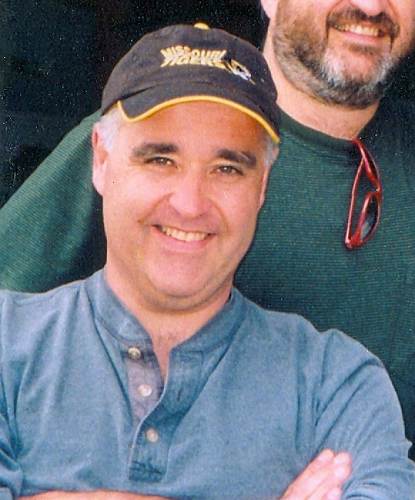
20 Sheldon McGowin He has written the history of Ulman for our website which you can read by clicking on the link.
Since Sheldon had to abbreviate some of his original history of Ulman for the website narrative, I have combined our website narrative with a longer article about Ulman written by Sheldon and present it here:
Ulman Carries Name of Early Settler
Sheldon McGowin
Joseph Ulman (photo 21) purchased land from William and Dianah Bilyeu (photo 22) in 1843, and from the Ulman families who settled in that area it became known as Ulman’s Ridge.
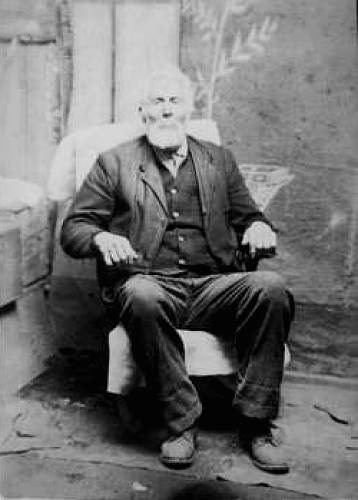
21 Dr. Joseph M. Ulman
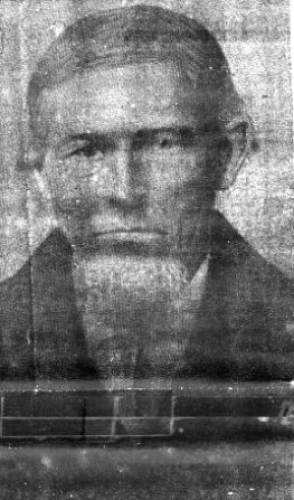
22 William Bilyeu In March, 1861, the first State Guard Company, having a strength of over 100 men, was organized at the house of Joseph Ulman. This company upheld Governor Jackson, who favored Secession. Members of the Ulman families, in the beginning, favored Secession and held allegiance to the South, except Andrew S. Ulman who joined the Union Home Guard forces as Second Lieutenant in Company D.
A log building served as the first school, raised in 1835 on the John Davis Plantation. The next building was the typical “little red school house” with homemade desks, benches, etc. which provided the students with lots of splinters. This building stood on the farm now owned by Gene Edwards. The town children later attended classes in the Modern Woodmen Hall in the middle of town until a school house was erected across Highway C, where it still stands.
This school building was built in 1912-14 and contained two rooms, one of which housed the first six grades; the other held the seventh and eight grades and first two years of high school. This was in operation until 1964 when the district was consolidated with School of the Osage.
A post office was established at the site of "Ulman's Ridge" in 1857 with James Karr as the postmaster, but a town or village was not platted and filed for record until Nov. 4. 1889. It had a population of about 50 people at that time, with a general store and a blacksmith shop set up for the folks who lived in the surrounding countryside. It was actually considered a "settlement" in 1889. Other "settlements" in Miller County at the time included Charlestown/St. Elizabeth, Mary's Home, Rocky Mount, Pleasant Farm and Ramsey (per Goodspeed's 1889 history of the area). In 1885, William Coburn was postmaster and livestock dealer (photo 23).
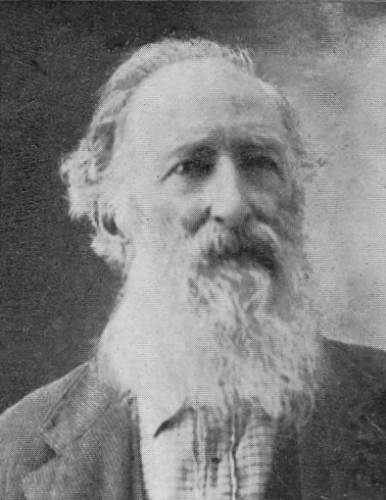
23 William Coburn The post office had been located at different sites since its beginning, starting at the present home of Julia Jackson, then only a stopover for the mail en route to Jefferson City from Lebanon by horseback. The post office was also housed in the corner of Charles Bass’ store until it was finally moved into the building vacated by the Bank of Ulman (photo 24).
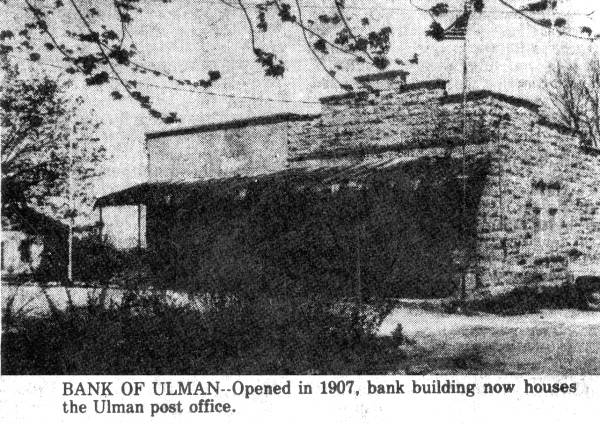
24 Bank of Ulman Postmasters serving the office at Ulman since 1898 were: Nora C. Sullivan, Alonzo Reed, Fred Williams, Charles Bass, Stella Pemberton, Julia Jackson, Pearl Graham, and the current postmaster, Myna McGowin.
Note: Presently Myna is retired; the most recent postmaster who now is retired but not yet officially replaced by the state is Peggy Myers.
William & Elizabeth (Rice) Coburn moved into Miller County in the years following the Civil War.
William was born in Ohio about 1834 and Elizabeth was a native of Pennsylvania, born in 1835. They married around 1855 and when they came to Miller County they had 5 children (all born in Illinois per census). Joseph M. Coburn, who was probably a brother to William, had settled in the Ulman’s Ridge area of Glaize Township before 1870. In his household in the 1870 census was his wife Elizabeth (Pumphrey) and a daughter, Minnie.
Twelve lots made up the original town of Ulman's Ridge. In October 1871, William & Elizabeth (Rice) Coburn purchased 160 acres from Deborah Phillips, widow of Joseph S. Phillips, for $1600. On Nov. 4, 1889, William & Elizabeth recorded a plat for the new town keeping the name "Ulman's Ridge" creating an addition of 20 more lots. However, early on it was also known by the nickname “Needmore.” It was a small village with only three blocks and two streets laid out which they named High & Front Streets. In 1894, they added 5 more blocks to their town calling it "Coburn's First Addition to the town of Ulman's Ridge."
Later, “Ridge” was dropped from the name, leaving the town now known as Ulman, which became a banking center, a milling center, and a trading center of much importance.
William & Elizabeth Coburn donated land to the Methodist Episcopal Church of Glaize Township in 1888, whose trustees were Peter Lupardus, Almon C. Keyes and William Coburn. In 1903, they gave the church an additional piece of land. In 1897, they donated a parcel of land to the Ulman Baptist Church, whose trustees included Joseph D. Shikles, Isaac Wilson Hendricks, and Phineus George.
In July 1905, they donated a small parcel of land to the Ulman Camp No. 8009 of the Modern Woodmen of America who constructed a meeting hall on the location.
William & Elizabeth (Rice) Coburn were parents of eight children:
1. Rececca Jane Coburn born IL married Jinkins Williams, Nov. 28. 1878
2. Clarence W. Coburn born 1860 IL (no marriage record found)
3. George J. Coburn born 1863 IL married Sophia Woolsey, 11/17/1895
4. Charity Samantha Coburn born IL married Alexander R. Gott. ????
5. Albert C. Coburn born 1870 IL (no marriage record)
6. Frank A. Coburn born 1873 MO married Mary McClain 1/17/1905
7. Theodore Coburn born 1879 MO. (no marriage record)
8. Clinton J. Coburn born 1877 MO. died 1878 age 1 yr.
During the Miller County census of 1880, William & Elizabeth were living in the Ulman's Ridge area with six of their eight children. Their youngest son died in 1878 and their oldest daughter Rebecca had married Jenkins Williams in 1878. Their neighbors in 1880 were the families, Reed, Witt, Sullivan, Carico, McComb, Vaughan,.Wilcox and Wyrick.
The William Coburn Family moved from Miller County sometime around 1907/1908 and moved westward settling in California. Joseph & Elizabeth (Pumphrey) Coburn remained in Miller County and are buried at Gott Cemetery. William died in California but I do not know the date. Elizabeth (Rice) Coburn died in San Diego, Calif., 1/28/1935, a month short of her 100th birthday. She is buried in San Diego, but I do not know for sure where William is buried.
William & Elizabeth were instrumental in the founding of "Ulman's Ridge". They did not remain in the community to see it become a hub of activity during the early to mid 1900s. By 1932 the business places include a general store owned by Robert Reed; another general store was operated by Roy Williams; a mill was owned by Elmer Sloan, a Farmers Exchange was in the small town managed by A. F. Bilyeu (photo 25); and a telephone exchange was operated by Bert Lupardus.
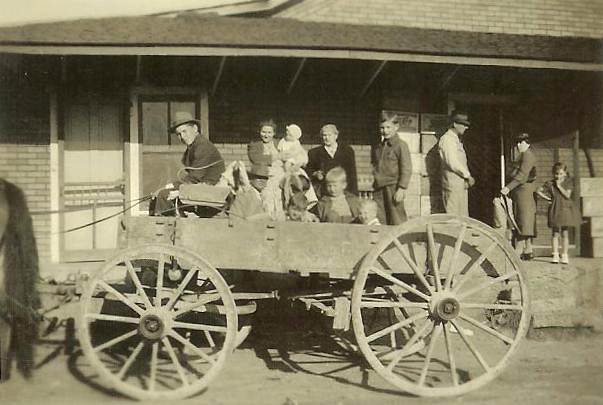
25 Ulman MFA Exchange - Jim Patterson family in Wagon Charles Bass was the town's postmaster during these years. The Bank of Ulman was begun in 1907, about the time that the William Coburn family moved from Miller County to California.
The Bank of Ulman was built in 1907; the officers were John Reed, Barney Reed, Wolff Dawson, Dr. Duncan, Paul Nixdorf, Bird Watkins, Henry Bear, and John Wilson, among others at different times. The bank building was purchased by Charles Bass when the bank was liquidated.
Note: Here is a better photo of the Bank of Ulman with the seven officers listed above standing in the order described from left to right (photo 26):
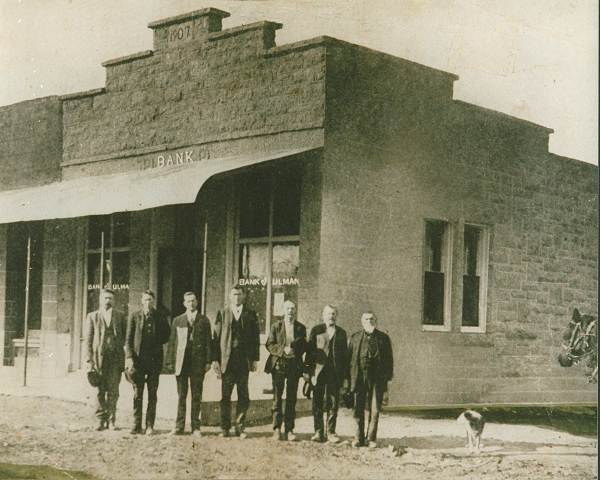
26 Bank of Ulman Peggy Hake wrote a short narrative about the old bank and its change over to become the Ulman Post office in the following article:
BANK OF ULMAN
By Peggy Smith Hake
I do not know for sure when the Bank of Ulman organized but it was 100 years ago, in 1907, that the first building was constructed in the middle of the small village (once called Ulman’s Ridge before, during and after the Civil War years).
NOTE: The post office at Ulman’s Ridge was in existence from 1857-1895 and the present post office was renamed Ulman in 1895.
In 1907, the Board of Directors of the Bank of Ulman included seven men:
1. John B. Reed, who was a resident of the Ulman community. He was born in 1866 in Miller County and married Cora Markle in 1893. By 1919, he was the bank’s cashier.
2. Walter “Wolf” Dawson, born in Missouri in 1850. He lived in Equality Township, a few miles northeast of Ulman with his wife, Lena (Markle). She was a niece of John B. Reed and his wife, Cora Markle Reed. In an old Miller County Autogram, dated Jan 26, 1905, was found the following news item…”Wolf Dawson of Ulman says he may be getting old, but he’ll never get ugly!”
3. Dr. George W. Duncan was a son of James and Sarah Duncan of eastern Miller County. His father was a native of Nashville, Tenn. Dr. Duncan and his wife, the former Myrtle Ramsey, lived in Iberia.
4. Paul Nixdorf…his name was Anthony Paul Nixdorf Jr., born in Miller County in 1874. He was a son of Dr. Anthony Paul Nixdorf Sr., a native of Germany. Paul Jr. married Ida Cooper in 1901 and they lived near Pleasant Farm, Osage Township, a few miles northeast of Ulman. By 1919, he was the bank’s president.
5. Bird T. Watkins was born in Miller County in 1858. He and his wife, the former Mary Ann Hughes, lived in Richwoods Township in the Hickory Point community in the Little Richwoods.
6. Henry Bear, born in Ohio in 1837, came to Miller County with his parents when he was a young boy. Henry first married Lucinda Spearman and after her death, he married Virginia F. (Livingston) Castleman, widow of Benjamin Castleman. They lived in Glaize Township near Ulman at the turn of the 20th century.
7. John Wilson was born in Miller County in 1852 and was a member of an early pioneer family of the county. In 1870, John married Susan Martin and they were residents of Glaize Township.
Today, 100 years after construction, the old Ulman Bank building is used as Ulman’s post office.
Ulman Post Office – Postmasters
James H. Karr, 4/11/1857
Joseph S. Phillips, 7/19/1859
Clayton S. Phillips, 5/10/1866
Theodore B. Doolittle, 11/20/1866
William Coburn, 12/13/1877
Alonzo Reed, 6/15/1889
James A. Belshe, 1/12/1891
John B. Norwood, 10/16/1893
Margaret Norwood, 2/ 6/1894
Barney Reed, Jr., 4/25/1895
Taylor F. Sullivan, 5/15/1897
Nora C. Sullivan, 4/20/1898
Alonzo Reed, 2/09/1899
Nora C. Meyers, 5/10/1900
Fred L. Williams, 7/31/1902
Charles B. Bass, 8/03/1914
Mrs. Stella D. Pemberton (Acting) 8/01/1943
Miss Julia Jackson, 4/09/1946
Mrs. Pearl J. Graham (acting), 5/31/1961
Mrs. My(r)na J. McGowin, 3/26/1963
Tennyson F. Patterson (Officer in charge) 3/10/1983
Billie M. Ash, 6/25/1983
Tennyson F. Patterson (Officer in charge) 6/08/1984
Peggy D. Myers, 10/13/1984
Thanks Peggy. Now back to the Ulman history as written by Sheldon McGowin:
During the town’s existence there have been three churches established, the first being the Methodist which was burned and never re built. The Methodist Church stood where the MFA Exchange was later built. The Baptist Church was organized in 1897 in the eastern part of town, later moved to its present location with a new building north of town on Highway C in 1968. The Ulman Christian Church was completed in 1921, the ground and money to build the church being donated by Simeon Bear as directed by his will at the time of his death. There have been additions to the original building in 1930 and 1970 and it is located near the north entrance of town on Highway C.
During the heyday of the town there were several stores and businesses. These included general stores (photo 27), blacksmiths, garages, sawmills, milliner shops, drug stores, restaurants, barber shops, hotels and a telephone exchange.
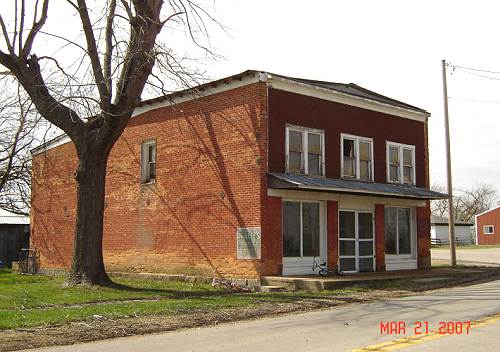
27 Ulman Mercantile A fire was among the greatest contributors to the decline of businesses which were not rebuilt.
The Ulman Milling Co. (photo 28) was located at the south end of town, which was last operated by Lou McCommons (photo 29) and Rufus Crismon.
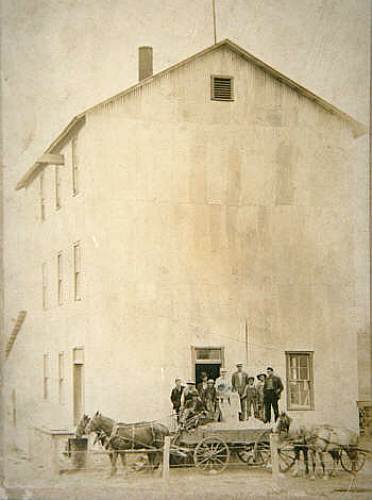
28 Ulman Mill
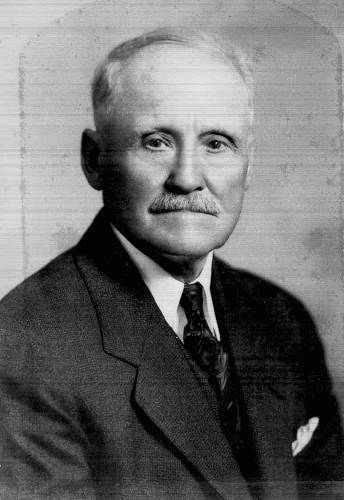
29 Lou McCommons It ran day and night supplying flour and meal to its customers. The milling company was sold to the Missouri State Penitentiary and was transported to Jefferson City across the Osage River at Tuscumbia which at the time was spanned by a wooden "swinging bridge". The last load which was the steam boiler, broke through the bridge with the back tires. They had to jack the tires back onto the bridge and one of the prison trustees who was assisting with the moving, volunteered to drive the load the remainder of the way across the bridge. For this his sentence was decreased by a number of years, enough to make him a free man.
Due to the lack of business opportunities and job requirements, Ulman has slowed down to a small community status. The community consists of mostly older, retired families who have to commute several miles each day to their employment. There are a few large farms in the area, but most of the farms are smaller operations whose proprietors have outside employment.
Ulman was the home of Henry Clay Jackson, a second cousin to Andrew Jackson (photo 30).
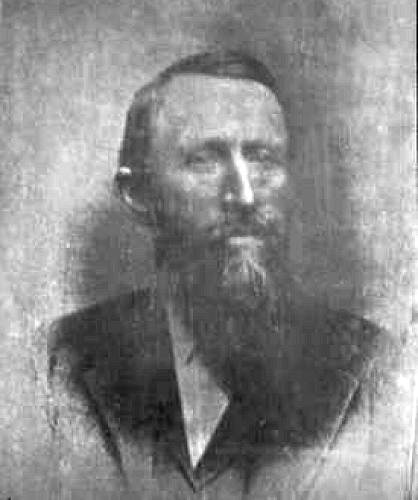
30 Henry Clay Jackson He was born in Louisiana, Missouri, where his family moved to from Kentucky after coming from Ireland. He married Sue E. Chadwick and their home, south of town, was still standing only until recently (photo 31).
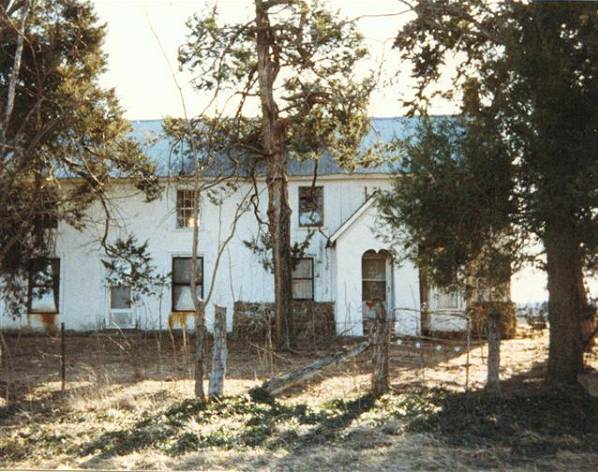
31 Henry Clay Jackson Home Mr. Jackson lived to the age of 92 1\2 years. The only living child, Julia, lived in the family home until the time of her death several years ago (photo 32).
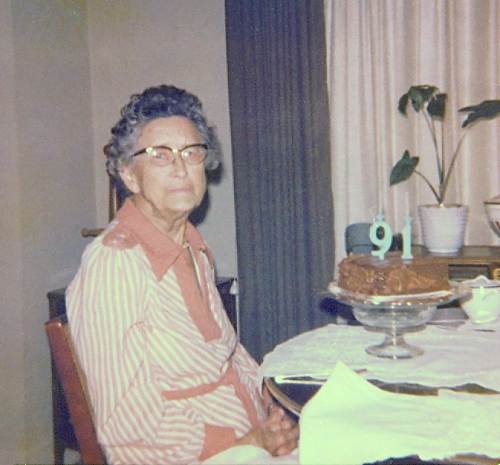
32 Julia Jackson The home contained many antiques including a style block at the front entrance of the property which was used during horse back riding days.
Interviews: Julia Jackson, T.F. Patterson, Clyde Lee Jenkins, Logan Stone, James Myers.
Thanks Sheldon for this very complete history of Ulman.
Peggy Hake wrote an article several years ago describing more information she had learned about the Henry Clay Jackson home:
THE HENRY CLAY JACKSON HOME – Historic Landmark
By Peggy Smith Hake
Here is the obituary of Henry Clay Jackson:
OBITUARY OF HENRY CLAY JACKSON
“Henry Clay Jackson was born 22 Nov 1839 at Louisiana, Pike Co., MO. He was educated in the schools there and attended college in Fayetteville, Ark. It was said that he rode a mule from his home in Pike Co. to Fayetteville to get his higher education. He married Sue Elizabeth Chadwick at Warrensburg, MO. on 23 Apr 1872. They became parents of 7 children: Julius, Walker, Barnard, Hattie, Julia, Lee, and Marguerite. They came to Miller Co. in 1878 and started Linwood Farm near Ulman. They came by a two-horse wagon loaded with their belongings.
In 1885, he affiliated with the Brumley Christian Church and was a member for over 47 years.
At the age of 92 years, on June 23, 1932, he died at his Linwood Farm home. On a Sunday afternoon in the old, historic house that dated back well over a century, and under the shade of the maple trees, his services were conducted. He was buried at the Eldon City Cemetery.”
Part of the house where Henry Clay Jackson lived pre-dated the Civil War and built of logs from the virgin forests nearby. It later was covered inside and out with cherry lumber which grew on Linwood Farm. Many doors were solid walnut. One of the farm buildings also contained the same material. Some of the lumber was cut with a whipsaw. The nails holding it together were the old 'cut nails' that the present generation knows little about. It held fine pieces of furniture of solid walnut dating back several generations. One book of accounts was dated 1832 and recorded the barter of slaves. The desk held an old Webster's dictionary dated 1859. Other books were dated in the 1840's.
ADDEUM… The above obituary has much historical and genealogical data recorded. I searched a little deeper to learn more about the old, historical home of Henry Clay Jackson. The line of ownership began in 1840 when John and Andrew Bilyeu patented 240 acres. They sold their acreage to Emly Golden in 1857 and at that time Emly patented another 65 acres making the complete tract of land containing 305 acres. Emly Golden was a famous Civil War soldier in Miller County history, a Lt. Colonel in McClurgs Osage Regiment (Union Army). I can not determine if the Bilyeu family built the house in question or if Mr. Golden built it after he bought the land in 1857. I suspect the Bilyeu family built the house and lived there until they pulled up stakes and moved west to Oregon territory in the mid 1850's.
After the Civil War, Emly and Sarah (Ulman) Golden sold the land to Theodore and Amanda Doolittle of Geauga Co., Ohio. They came to Miller Co. circa 1867 and lived in the home for several years. During their stay in Miller Co., their two daughters married local men: Estella A. Doolittle married Dr. Joseph M. Ulman and Lydia K. Doolittle married Andrew C. Thompson. On 28 Sept 1878, Theodore and Amanda Doolittle sold the land (305 acres) to Henry Clay Jackson of Pike Co., MO. Selling price--$3,500.00. After buying the land, Henry Clay obtained permission to name his new home Linwood Farm, the first farm in Miller County to receive a legal name of record.
Thanks Peggy.
Julia Jackson, daughter of Henry Clay Jackson, was well known in the Ulman community known as a very strong and independent woman. She never married although she did have male friends at times, one of them being Jackson C. Stanton of Tuscumbia.
Doris Wright Clemens wrote a short paragraph of her memories of Julia Jackson and Julia’s father, Henry Clay Jackson, in a book she wrote about Tuscumbia titled “Life…A Trail of Memories:”
“The Jackson family came (to Tuscumbia) from their farm across the river near the small town of Ulman about fifteen miles away. They were sure customers before the day was over. Their old maid daughter Julia drove their big Hudson like a chauffeur. The mother and father rode in the back seat. They always went through town early on Saturday morning on their way to Eldon to shop for dry goods. In early afternoon they came back to shop at Aunt Ida's (Hauenstein) for groceries on their way home. They were wealthy----the only farmers in the area to own an automobile. Mr. Jackson had made his money buying and selling cattle. Like a true cattleman he always wore his black Stetson hat. The mother and daughter were always dressed in the height of fashion. As a young teenager I admired Julia's attire and her social graces and demeanor. She entered the front door of the store with her kid gloves (driving gloves) and fancy hat on. A tall slender lady of noble carriage and stature, she made quite an impression on me. An attorney, Jack Stanton (photo 33), was a close friend of Julia Jackson's.
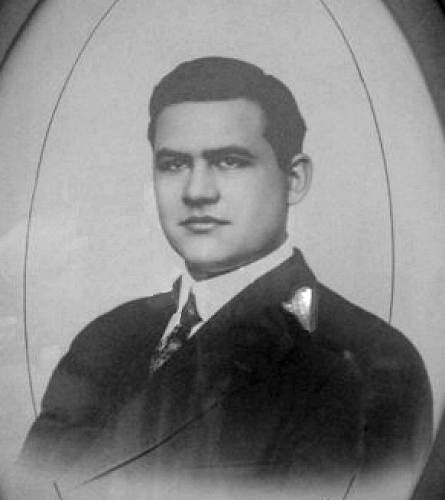
33 Jackson C. Stanton Originally of Miller County stock, he lived most of his life in Kansas City. Upon retirement he built a law office in Tuscumbia and practiced. Julia's parents were dead then, but she still lived on the farm near Ulman. Before Jack died he had a large, oblong monument erected possibly ten or twelve feet tall in the country cemetery near Linn Creek named Freedom Cemetery. On it, his lifetime history was engraved. He was a man of great personality as well as size and his tombstone is equally imposing.”
You can read more about Doris’s memories at this previous Progress Notes.
Buster McGowin knew Julia Jackson very well. He has told me many stories about her. Although she may have seemed somewhat aloof to others she and Buster always had a good relationship. He said he was the only one she would allow to hunt on her large farm just outside Ulman. Before she died she seemed to know it was time to direct the placement of her more valuable belongings. One day she called Buster to come over as she was going to give him all her guns and pistols. Buster said some of these were very old. After she passed away, one of her relatives from out of state came to Buster’s home to ask if he could purchase a particular gun owned by Julia. Buster said he sized the man up and told him, “No, but instead I will give you the gun!” The man was quite surprised and delighted.
Buster told me that Julia was related in some way to Jack Hinkley, father of John Hinkley, the young man who made an assassination attempt on President Ronald Reagan. One time the family including John came to a funeral near Ulman. Buster didn’t know the exact details. However, one of the things Julia left for Buster was a card sent her by the Hinkleys’ (photos 34 and 35).

34 Card to Julia from Jack Hinkley - Father of John Hinkley
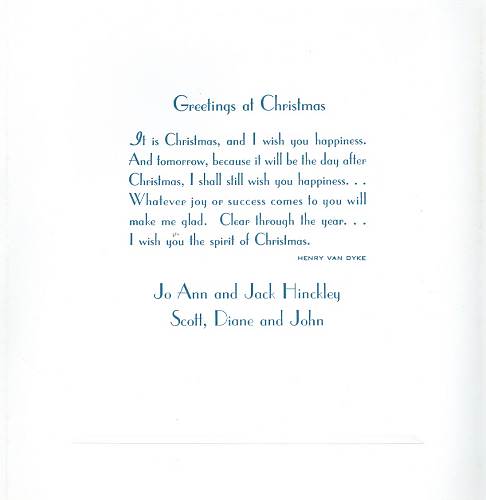
35 Message of Card to Julia from Jack Hinkley - Father of John Hinkley One of the reasons I have a special interest in Ulman is because a couple of my Bear ancestors lived in the area and were involved with the community. My great great uncle Henry Bear (photo 36) was mentioned above as being one of the first board members of the Bank of Ulman.
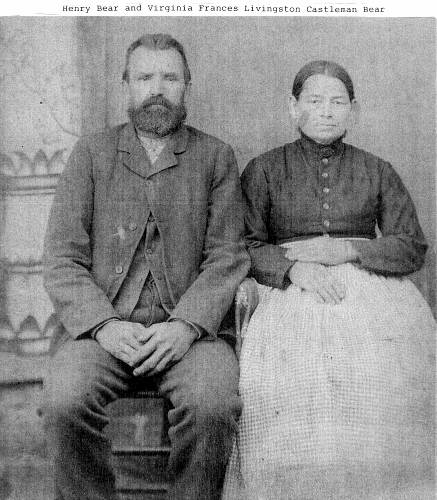
36 Henry and Virginia Bear His farm is now owned by Gene Edwards.
Henry’s brother, Simeon (photo 37), bought the home known in recent years as the “Nixdorf Home” from Joseph Coburn.
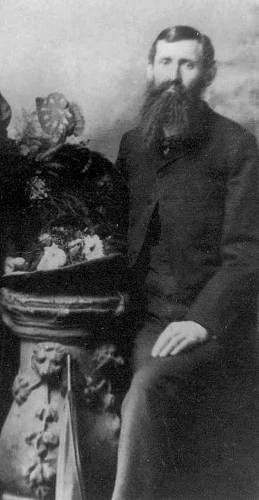
37 Simeon Bear Later, the heirs of Simeon sold the home to his brother and my great grandfather, David Christian Bear (photo 38).
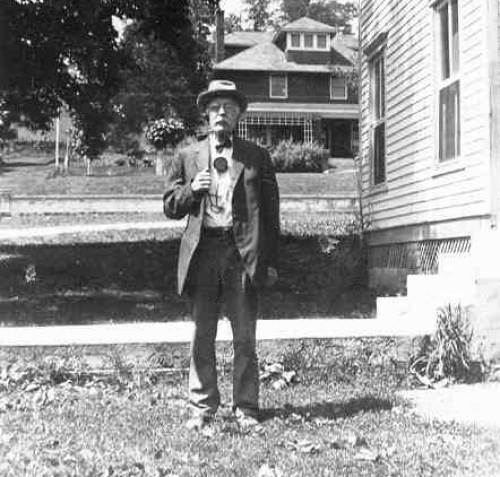
38 David Christian Bear One of the heirs of Simeon, Henry, may have lived in the home for awhile since I have in my possession a photo of Henry and his wife, Virginia standing in the front yard (photo 39).
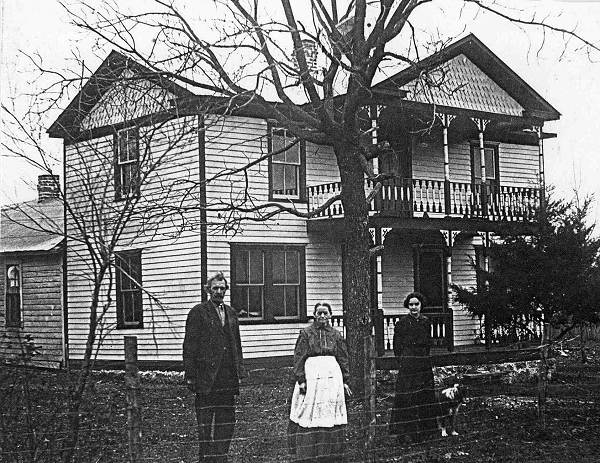
39 Henry Bear, Virginia and Lucy - Front yard of Coburn Bear Nixdorf home in Ulman David Christian Bear lived in the home for a few years until his wife, Samantha died and then he in turn sold the home to Anthony Paul Nixdorf (“Pal”) (photo 40), son of Dr. Anton Paul Nixdorf.
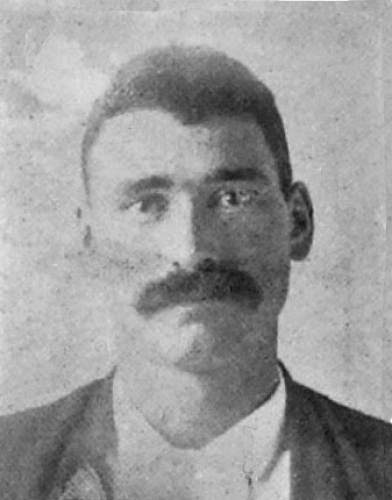
40 Anthony Paul Nixdorf That is how the home eventually became known as the Nixdorf house since it stayed in that family for many years (photo 41).
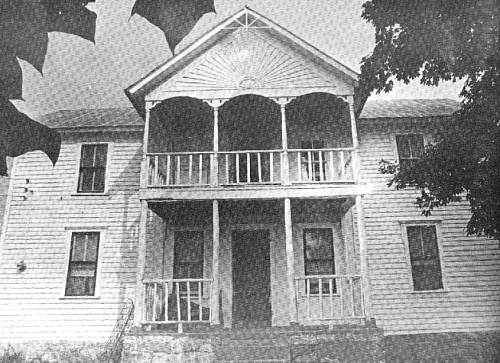
41 Nixdorf Bear Coburn House
Click image to read an article (PDF format) about the homeSadly, a couple of years ago the home burned. It was a very historic house.
Simeon, as noted above in the Ulman history written by Sheldon McGowin, directed in his will that acreage he owned be used for the construction of the Ulman Christian Church (photo 42).
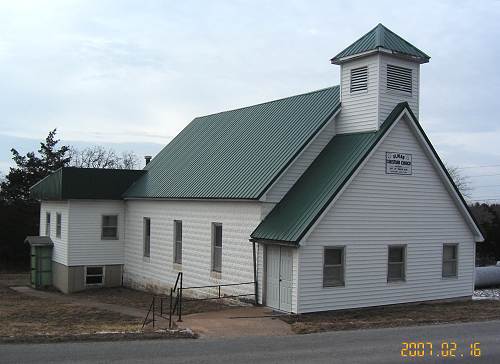
42 Ulman Christian Church Simeon’s name is on the sign above the entry door (photo 43).
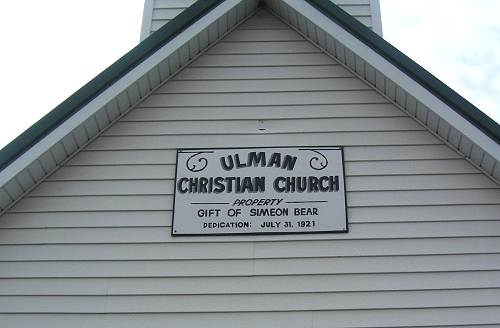
43 Ulman Christian Church Nameplate Buster McGowin has attended church there for more than fifty years and his wife, Myna Patterson McGowin, was raised in the church. Myna wrote the history of the church as follows:
ULMAN CHRISTIAN CHURCH
By Myna McGowin
Simeon Bear (photo 44), a pioneer resident of Ulman, willed one acre of ground and one thousand six hundred dollars to be used in the building of a Christian Church building in Ulman.
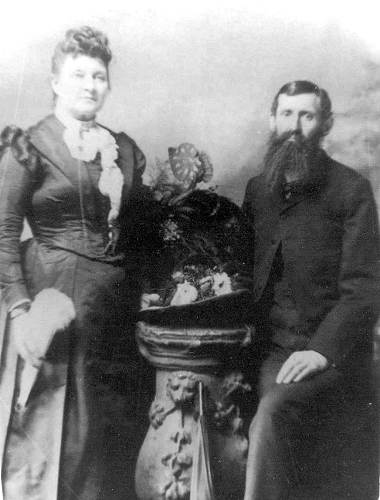
44 Simeon and Louisa Bear He appointed A.C. Jackson, James C. Thompson and
George Bear as administrators of this building fund and land to see that his will be carried out.
The church building was erected in 1921. The contractors moved their machinery to the site of the building and made the blocks of which the building was made.
Some of the charter members were: Mrs. A.P. Nixdorf, Mrs. R. Crismon, Mrs. Grace Hix, Mr. and Mrs. Rig Patterson. After the building was completed James C. Thompson appointed Rufus Crismon, A.P. Nixdorf and C.B. Bass as trustees.
A Bro. Brown held the first revival meeting and dedication during which time a great number members were added. Br. W.H. Scott became the first pastor of the church and Mrs. C.B. Bass was the first Sunday school superintendent. Mrs. Lora Abbett was the first pianist.
The building still stands as it was erected in 1921 with the addition of a belfry in 1930. A new pine floor has been placed over the original concrete floor and the interior redecorated.
In 1970 an addition was placed on the back of the original building which houses classrooms and a basement.
As one enters the sanctuary one notices that over the pulpit is a beautiful mural provided by Joanne and Vergil Roark (photos 45 and 46).
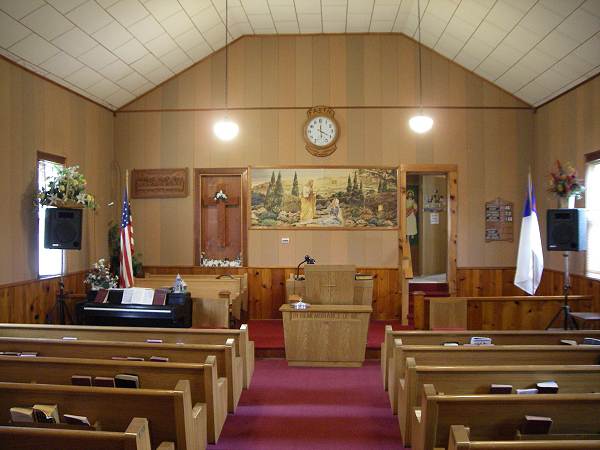
45 Church Sanctuary
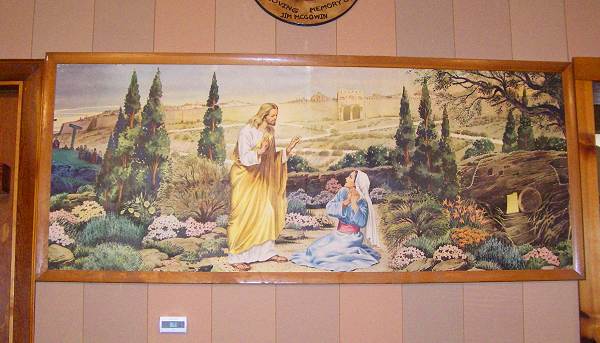
46 Mural The clock above has ornate decorative features made by Buster’s grandson Josh, who is named after Buster’s father, Josh McGowin (photo 47).
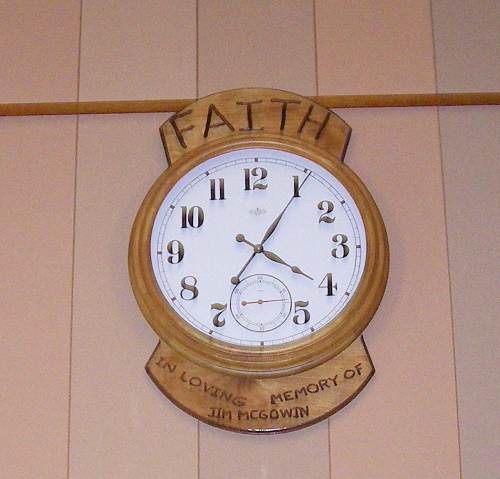
47 Clock Buster showed me a handmade wooden replica of a church made by Harley Lupardus used for offering collections each Sunday Morning (photo 48).
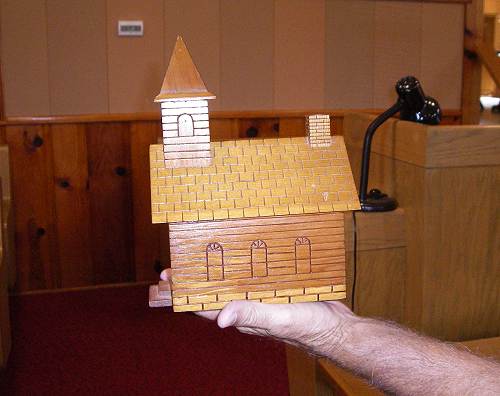
48 Church Collection Container In the foyer of the church is a color reproduction of an old photograph of Simeon Bear and his wife, Louisa (photo 49).
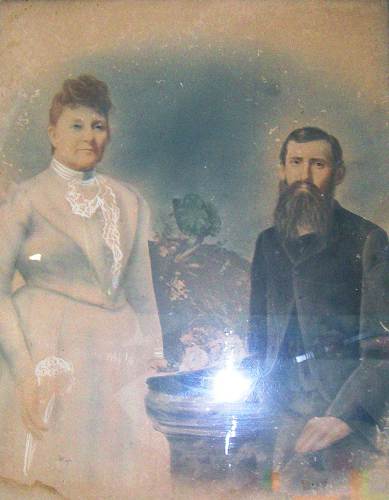
49 Color photo of Simeon and Louisa Bear
So it is that a story which begins with a fisherman in Linn Creek ends in a church in Ulman where is taught the story of the “Fisher of Men.”
The new Tuscumbia bridge crossing the Osage River will be opened to the public on Monday, August 16 following an opening program at the north end of the bridge which begins at ten a.m. Officials and specially invited guests will have reserved parking along Highway 52/17 going north from the junction on the north end (see map photo 50).
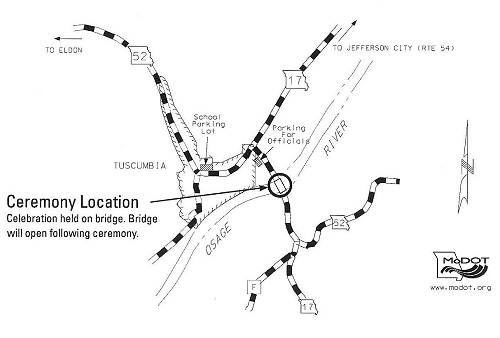
50 Tuscumbia Bridge Opening Celebration Map
Click image for larger viewAdditional parking and a shuttle will be available at the Tuscumbia School parking area located on Highway 52 north and west of the bridge on top of the hill. Here is a photocopy of the official invitation (photo 51).
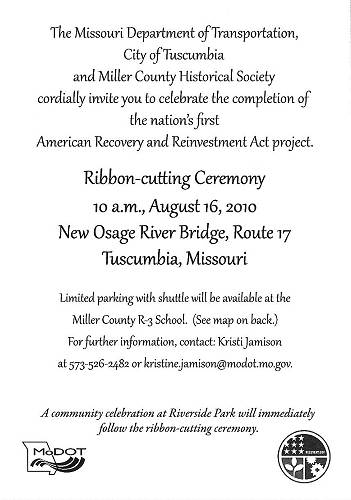
51 Tuscumbia Bridge Opening Celebration Invitation
Click image for larger viewFollowing the program a parade will proceed from the south end of the bridge to the north end. The parade will consist of the Eldon Marching Band and a cavalcade of cars carrying a number of Miller County residents who have the distinction of having crossed the old swinging bridge before it was replaced in 1933 by the present bridge. Now it too will be replaced by the new bridge August 16.
After the parade musical entertainment and food will be provided at the Riverside Park in Tuscumbia.
Last week I placed some anecdotes remembered by some of our older Miller County residents who had crossed the old swinging bridge. One of those quoted was David Bear, who is my mother’s brother. This week I have a quote from a recorded conversation David and his brother Arthur Bear (photo 52) had more than twenty years ago about some memories of the 1933 bridge, the one currently being replaced:
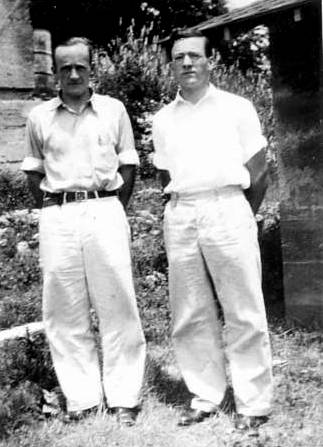
52 Arthur and David Bear Arthur: Well, I was just going to say something I could have said earlier. Just as the dam was completed in either 1931 or 32, they started working on a bridge across the Osage River at Tuscumbia. This was to replace an old one-lane suspension bridge that was owned by a local corporation. There was a toll fee for crossing it. It had become dangerous. I don't know how long it took to construct the new bridge, but it was quite awhile. It made a lot of employment but nothing like that created by the dam. It was finished in 1933 and this was followed by a dedication just a month after Lena and I were married. That was a big event. The governor and other state officials were there. I remember that they served about 4000 pounds of hamburger.
David: They also served a lot of barbecued ribs. The barbecuing was done on Jim Johnson's little piece of ground just across the street from our garden in Goosebottom. The crew dug some trenches for the barbecue pits, then erected something above that to lay the ribs on. I don't know what they used for the heat. I suppose that the ceremonies were held in the park.
Note: Last week I presented a photo of the Riverside Park where the barbecue and bridge celebration occurred. As I noted then, the home in the upper left corner of the photo was where my mother and her two brothers, Arthur and David, were raised (photo 53).
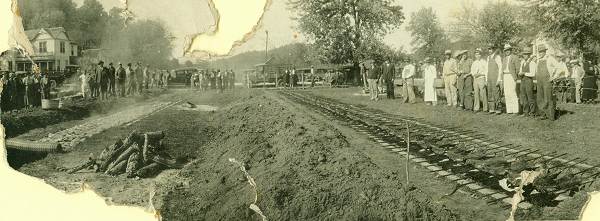
53 1933 Bridge Celebration Riverside Park
Click image for larger viewArthur: I read a few years ago that the bridge cost $135,000. Think about it. Today the cost would be several million dollars.
David: Well, during the building of the bridge, Mom did make a little money by renting some rooms to workers. We had a ten room house and a little building in the back which we called a smokehouse, but it really wasn't. This little building had two rooms which were fixed up to accommodate two or three workers. Most likely we rented two rooms on the lower floor of the house. During the construction of a road south of the bridge Mom rented two upstairs rooms to a man and his wife. We rented out some of the rooms for several years, and it brought in a little money to keep the family going. Mom and Dad were both enterprising people.
That’s all for this week.
 Joe Pryor
Previous article links are in a dropdown menu at the top of all of the pages.
|

